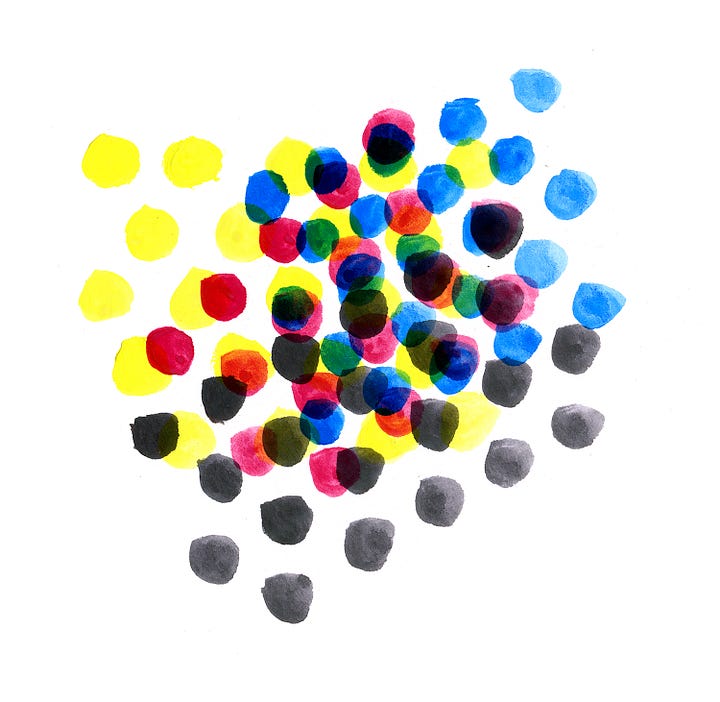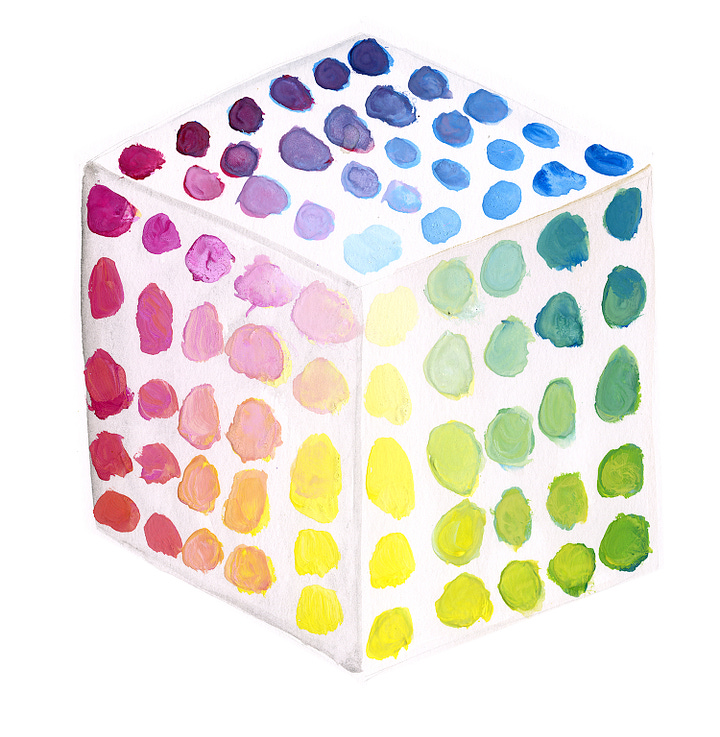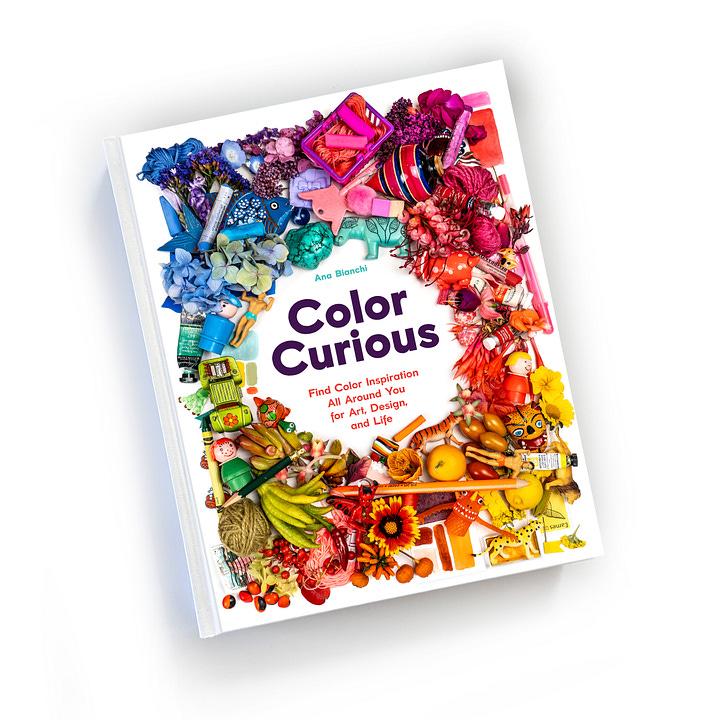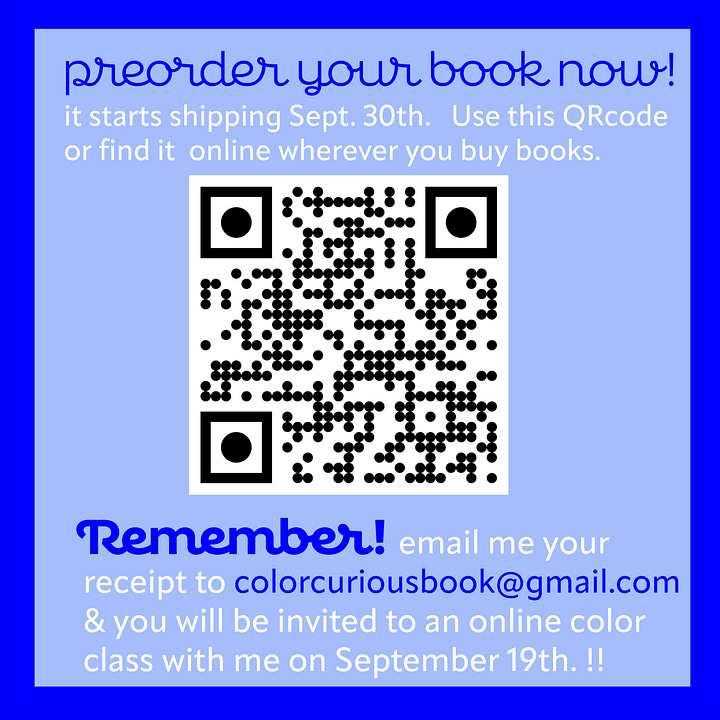The short answer is NO. A more nuanced answer is you probably already know the basics -yellow and blue make green, there are 3 primary colors and 3 secondary colors, red and green are complementary, etc-. Remember your art class in school? So what is the deal about color theory.
Color theory is based on all the science behind how color happens and how it is perceived by our eyes. It is all interesting and fascinating, like science things are, but TRUST ME understanding the science of color theory is not that important and mincing through Newton’s notes does not guarantee you will become a great artist or colorist.
You know what will? training your eye for color and developing your color voice. That is what I have done all along my creative journey….big secret: I don’t fully understand a lot of the science of color and you know what? I have done pretty well in regards of my color love. This notion -color theory is not a prerequsite for art making- is one of things I talk about early in my book “ColorCurious” (Chronicle Books).


I did study color theory and did gruelling color exercises when I was in Design School, but honestly I have learned so much more from a consistent practice based on observation and intuition. That is how I developed my eye for color and that is what “Color Curious” is all about, helping you see and understand color in a totally different way, a way that is meaningful to you.
How many ways to slice a cake…a color cake.
When I set out to write and illustrate this book with all I’ve learned about color, I thought of the analogy of how to slice the cake. Everyone slices a cake using a different method: wedges, slices, chunks. It was the same thing with talking about the vast theme of color.
• I could have based my book on color theories, but as I said, that is not my jam.
(more about this in my interview with the podcast TwoCrankyCreatives airing August 20th)
• I could have organized the book's images by rainbow and have chapters follow the colors: red, orange, yellow, green…. beautiful eye-candy but that would have fallen short in regards of some of my ideas of what color can do.
• I could have made a book full of images and palettes, a true coffee-table book, but I had so much to say, I needed words in the book. Plus that would have felt a bit like a visual ego-trip “oh! look at all this beautiful images and go sort out what to do with them”. I wanted also to be of service, to find a way to transfer the knowledge I’ve received or the things I learned on my own, and to deliver them in a way that would help and inspire others in their own creative path.
So, I found that what my book needed was a balance between beautiful inspiring images and color palettes, essays about color themes that would be full of inspiration, the learnings I got from my mentors and lifelong love for art, and a series of hand’s on playful exercises for readers to practice the color notions and push their creativity towards finding their own color voice.
This is how I sliced the cake:
Lets look at the index
First: What an honor to have the wonderful
aka The Jealous Curator write the preface!Her preface is followed by my intro about how to become color curious and how to “color harvest” intuitively (that thing I do of gathering color things and combining them and observing them and getting color inspiration. In the extended intro,there is….ok…hmmm…yeah…there is a bit about color theory, CMYK, RGB, color systems, pantone. But it is quite brief, barely a pass through acknowledgment.
Then come the chapters, the real meat of the book. These are not a rainbow, these are organized as a progression of color concepts in a way that will help anyone think and use color with more depth and intention:
1: Not the Basic Four-Color Crayon Box is about how to use each color to its full range, not just straight from the tube, with an exercise on color-rich monochromes
2: Color as a Leitmotif is how to take a favorite color and find endless ways to use it in combination with other colors.
3: Sideways and Across is about complementary colors (and adjacent and triads). This is the closest I get to the color wheel, but it is so not color theory, and it helps you really expand the range of combinations you can do with pairs or trios of color
4: The Joy of Multicolor Eye Candy is the most psychological of the chapters. It connects us with the joys of childhood and takes us to a way to harness the power of multicolor palettes with intention.
5: There is No White is all about whites: the various types of white paint, the color of light. Since there is no pure white, it is really about chromatic whites, those colors that are so pale you might think they are white, but when you observe them, they are not.
6: The Color in Enriched Blacks is similar to the chapter about whites, but with deep, dark colors: the chromatic blacks.
7: Sorry for the Interruption, is’s about how to use a pop of color and how to bring on a neon.
8: The Passing of Time considers color and time in various ways: aged color, vintage color, nostalgia, historic color, and how to apply that inspiration.
9: The Color of a Place, similarly, this is about using color to express a sense of place, world cultures, travel memories and, in an essay within an essay, how to use the inspiration without appropriation.
Finally, in a series of interviews with fellow artists, designers, and art agents, you will read about how they all use and apply intentional color palettes in their various creative practices -from illustration, to branding, from product design to crafts and personal projects- and how they all find their color voice.
Over the next weeks, I will be posting one of these color themes at a time, with detail and images about each one. Hope you follow along!


You can purchase the book anywhere you order books online or following the QR code to Chronicle Books my publisher.
Remember! When you email your proof of purchase to colorcuriousbook@gmail.com I will add you to the list for an online color class with me on September 19th!!
Want to hear more about the overall content of “Color Curious”? Listen to my conversation with Margo Tantau on her wonderful podcast “Windowsill Chats”.
Not only do we talk about color but also about keeping a mindful creative practice, the joys of becoming a keen observer and how you train your eye.
Listen to the episode here






